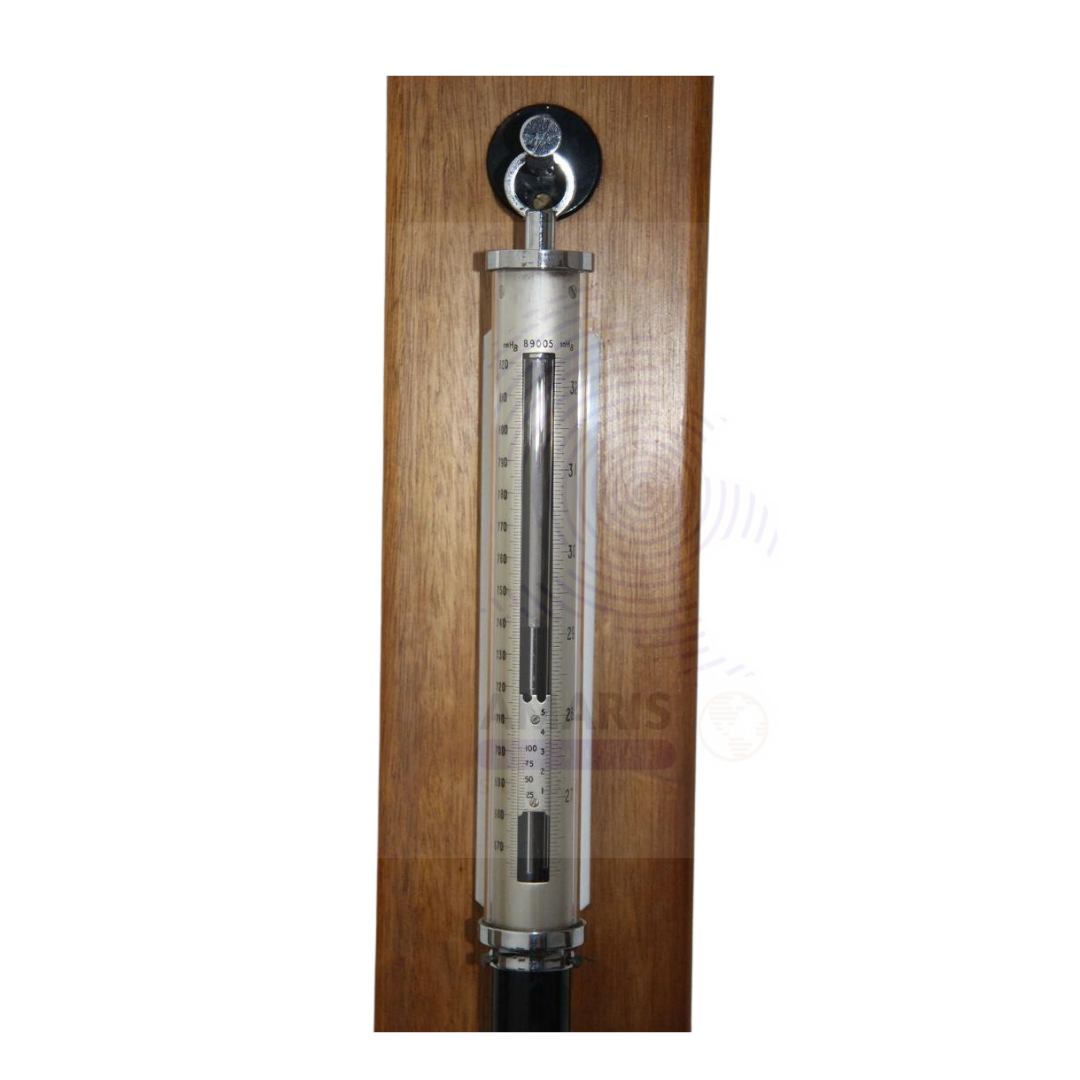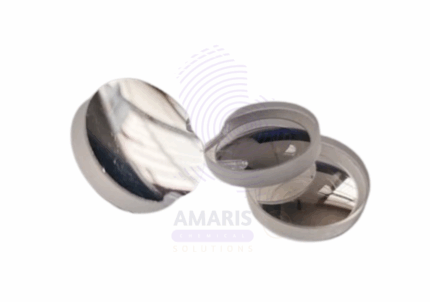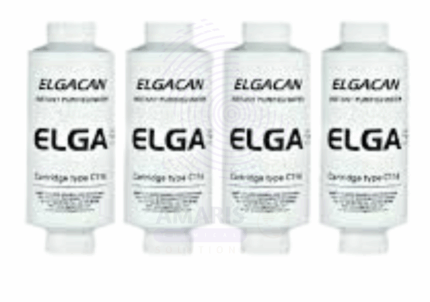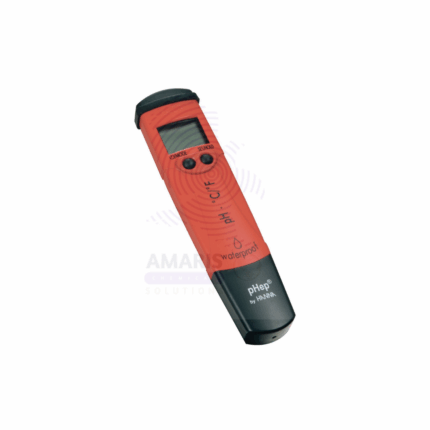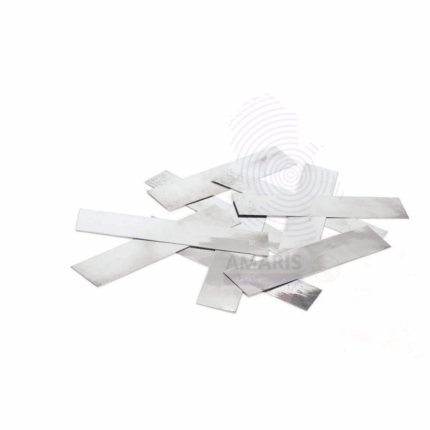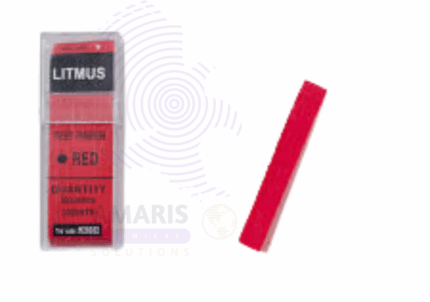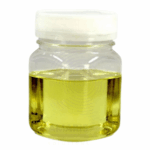

Fortin Barometer with Mercury
$ 17.52 Original price was: $ 17.52.$ 17.43Current price is: $ 17.43.
Fortin Barometer with Mercury is a precision instrument used to measure atmospheric pressure with high accuracy. Named after its inventor, Jean Nicolas Fortin, this barometer features a mercury column enclosed in a glass tube, mounted vertically with a cistern at the base. A screw-adjusted ivory point is used to align the mercury level at the reference point, ensuring consistent and accurate readings. The device includes a vernier scale for fine measurements and is enclosed in a protective casing for safe handling. Commonly used in meteorological studies, physics laboratories, and calibration settings, the Fortin Barometer is essential for barometric pressure determination and experimental demonstrations.
Fortin Barometer with Mercury
Primary Use
- Meteorological and Atmospheric Studies
- Accurate measurement of atmospheric pressure for weather observation and forecasting.
- Used in meteorological stations to monitor changes in air pressure for climate analysis.
- Supports calibration of other barometric and pressure-sensitive instruments.
- Provides baseline pressure data in meteorological modeling and field research.
2.Educational and Laboratory Applications
- Demonstrates principles of atmospheric pressure in physics and earth science curricula.
- Used in academic laboratories to teach the relationship between pressure and altitude.
- Helps students visualize and understand mercury displacement and fluid pressure concepts.
- Supports calibration experiments in physics and instrumentation classes.
Secondary Uses
- Calibration and Industrial Applications
- Used in calibration labs for standard reference in pressure-measuring devices.
- Supports precision-based instrumentation testing in research and development facilities.
- Applied in environmental testing setups requiring accurate barometric pressure input.
- Utilized in aerospace and aviation training modules for pressure-based altitude modeling.
1.Basic Identification Attributes
- Material: Borosilicate glass tube, mercury column, brass or aluminum casing, ivory point
- Components: Mercury column, adjustable cistern, vernier scale, protective outer frame
- Reading Scale: Calibrated in millimeters or inches of mercury (mmHg or inHg)
2.Physical & Chemical Properties
- High precision measurement capability
- Mercury provides stable and consistent readings due to high density and low vapor pressure
- Glass tube and metal housing offer good resistance to environmental fluctuations
3.Safety & Hazard Attributes
- Contains mercury, a hazardous material—must be handled with caution
- Risk of mercury exposure if the device breaks or leaks
- Must be used in well-ventilated areas and kept upright to prevent spillage
4.Storage & Handling Attributes
- Store upright in a secure, vibration-free location
- Avoid direct sunlight and temperature extremes to maintain mercury stability
- Handle with protective gloves and avoid tilting or inverting the barometer
5.Regulatory & Compliance Attributes
- Must comply with hazardous material regulations for mercury-containing devices
- Conforms to laboratory safety and metrological calibration standards
- Subject to regional mercury handling and disposal regulations
6.Environmental & Health Impact
- Mercury is toxic to humans and the environment—disposal must follow environmental safety protocols
- Use alternatives (aneroid barometers) in mercury-restricted environments
Safety Handling Precautions
- Wear gloves and safety goggles when transporting or adjusting the barometer
- Avoid contact with mercury—clean any spills using approved mercury spill kits
- Keep away from children and untrained personnel
First Aid Measures
- In case of mercury exposure, evacuate the area and follow proper spill containment procedures
- For skin contact, wash immediately with soap and water
- Seek medical attention in case of inhalation or ingestion of mercury vapors or droplets
Firefighting Measures
- Mercury is not flammable, but toxic fumes may form if exposed to high heat
- Use appropriate extinguishing agents for surrounding materials
- Avoid using water directly on mercury spills to prevent vapor release


 Preservatives(food)
Preservatives(food) Flavor Enhancers
Flavor Enhancers Acidulants
Acidulants Sweeteners
Sweeteners Antioxidants
Antioxidants Colorants(food)
Colorants(food) Nutraceutical Ingredients (food)
Nutraceutical Ingredients (food) Nutrient Supplements
Nutrient Supplements Emulsifiers
Emulsifiers
 Collectors
Collectors Dust Suppressants
Dust Suppressants Explosives and Blasting Agents
Explosives and Blasting Agents Flocculants and Coagulants
Flocculants and Coagulants Frothers
Frothers Leaching Agents
Leaching Agents pH Modifiers
pH Modifiers Precious Metal Extraction Agents
Precious Metal Extraction Agents
 Antioxidants(plastic)
Antioxidants(plastic) Colorants (Pigments, Dyes)
Colorants (Pigments, Dyes) Fillers and Reinforcements
Fillers and Reinforcements Flame Retardants
Flame Retardants Monomers
Monomers Plasticizers
Plasticizers Polymerization Initiators
Polymerization Initiators Stabilizers (UV, Heat)
Stabilizers (UV, Heat)
 Antifoaming Agents
Antifoaming Agents Chelating Agents
Chelating Agents Coagulants and Flocculants
Coagulants and Flocculants Corrosion Inhibitors
Corrosion Inhibitors Disinfectants and Biocides
Disinfectants and Biocides Oxidizing Agents
Oxidizing Agents pH Adjusters
pH Adjusters Scale Inhibitors( water)
Scale Inhibitors( water)
 Antioxidants(cosmetic)
Antioxidants(cosmetic) Emollients
Emollients Fragrances and Essential Oils
Fragrances and Essential Oils Humectants
Humectants Preservatives
Preservatives Surfactants(cosmetic)
Surfactants(cosmetic) Thickeners
Thickeners UV Filters
UV Filters
 Fertilizers
Fertilizers Soil Conditioners
Soil Conditioners Plant Growth Regulators
Plant Growth Regulators Animal Feed Additives
Animal Feed Additives Biostimulants
Biostimulants Pesticides (Herbicides, Insecticides, Fungicides)
Pesticides (Herbicides, Insecticides, Fungicides)
 Active Pharmaceutical Ingredients (APIs)
Active Pharmaceutical Ingredients (APIs) Excipients
Excipients Solvents(pharmaceutical)
Solvents(pharmaceutical) Antibiotics
Antibiotics Antiseptics and Disinfectants
Antiseptics and Disinfectants Vaccine Adjuvants
Vaccine Adjuvants Nutraceutical Ingredients (pharmaceutical)
Nutraceutical Ingredients (pharmaceutical) Analgesics & Antipyretics
Analgesics & Antipyretics
 Analytical Reagents
Analytical Reagents Solvents(lab)
Solvents(lab) Chromatography Chemicals
Chromatography Chemicals Spectroscopy Reagents
Spectroscopy Reagents microbiology-and-cell-culture-reagents
microbiology-and-cell-culture-reagents Molecular Biology Reagents
Molecular Biology Reagents Biochemical Reagents
Biochemical Reagents Inorganic and Organic Standards
Inorganic and Organic Standards Laboratory Safety Chemicals
Laboratory Safety Chemicals Specialty Laboratory Chemicals(Special Laboratory Equipment)
Specialty Laboratory Chemicals(Special Laboratory Equipment)
 Demulsifiers
Demulsifiers Hydraulic Fracturing Fluids
Hydraulic Fracturing Fluids Scale Inhibitors(oil)
Scale Inhibitors(oil) Surfactants(oil)
Surfactants(oil) Drilling Fluids
Drilling Fluids
 Dyes and Pigments
Dyes and Pigments Bleaching Agents
Bleaching Agents Softening Agents
Softening Agents Finishing Agents
Finishing Agents Antistatic Agents
Antistatic Agents
 Admixtures
Admixtures Waterproofing Agents
Waterproofing Agents Sealants and Adhesives
Sealants and Adhesives Curing Compounds
Curing Compounds Concrete Repair Chemicals
Concrete Repair Chemicals Anti-Corrosion Coatings
Anti-Corrosion Coatings
 Surfactants(cleaning)
Surfactants(cleaning) Builders
Builders Enzymes
Enzymes Solvents (Cleaning)
Solvents (Cleaning) Fragrances
Fragrances
 Electronic Chemicals
Electronic Chemicals Catalysts
Catalysts Lubricants
Lubricants Photographic Chemicals
Photographic Chemicals Refrigerants
Refrigerants Automotive chemicals
Automotive chemicals Pyrotechnic Chemicals
Pyrotechnic Chemicals
 Biodegradable Surfactants
Biodegradable Surfactants Bio-based Solvents
Bio-based Solvents Renewable Polymers
Renewable Polymers Carbon Capture Chemicals
Carbon Capture Chemicals Wastewater Treatment Chemicals
Wastewater Treatment Chemicals
 Pigments
Pigments Solvents(paint)
Solvents(paint) Specialty Coatings
Specialty Coatings Binders/Resins
Binders/Resins Additives
Additives Driers
Driers Anti-Corrosion Agents
Anti-Corrosion Agents Functional Coatings
Functional Coatings Application-Specific Coatings
Application-Specific Coatings
 Fresh Herbs
Fresh Herbs Ground Spices
Ground Spices Whole Spices
Whole Spices Spice Blends
Spice Blends Dried Herbs
Dried Herbs
 Leavening Agents
Leavening Agents Dough Conditioners
Dough Conditioners Flour Treatments
Flour Treatments Fat Replacers
Fat Replacers Decoratives
Decoratives Preservatives(baking)
Preservatives(baking)
 Plasticizers & Softeners
Plasticizers & Softeners Reinforcing Agents
Reinforcing Agents Adhesion Promoters
Adhesion Promoters Vulcanizing Agents
Vulcanizing Agents Antidegradants
Antidegradants Blowing Agents
Blowing Agents Fillers & Extenders
Fillers & Extenders Accelerators & Retarders
Accelerators & Retarders